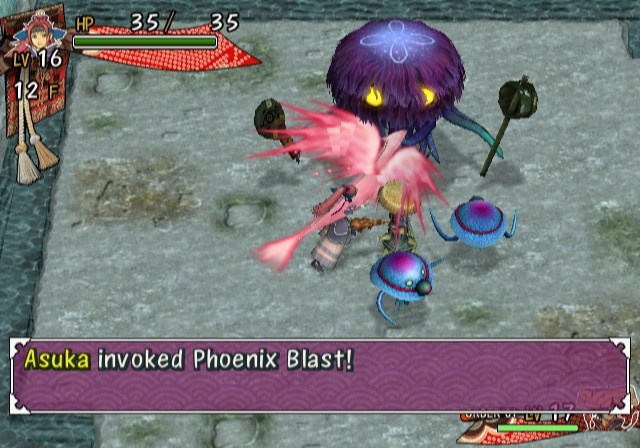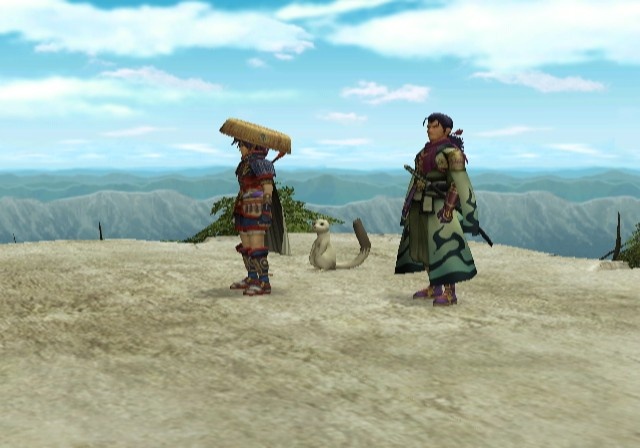Shiren the Wanderer Hands-On
As the silent and steadfast Shiren, we attempt to unravel the mystery behind the Karakuri Mansion.
Shiren the Wanderer on the Wii is not nearly as difficult as Mystery Dungeon: Shiren the Wanderer for the DS, which was released a couple of years ago. If you're hesitant about this game solely based on the title, there's no need. For newcomers to the genre, there is an easy setting if you're not looking to be punished at every turn. Shiren the Wanderer is a new adventure that blends real-time exploration with combat, but it's still turn based so you can access menus and debate your next move. After a few hours, as well as minimal deaths, the game started to grow on us with its simple but nonetheless charming visuals and pleasant soundtrack.

The silent samurai Shiren is accompanied by his loud-mouthed ferret Koppa, whose quips make up for the lack of dialogue coming from his master. Shiren's uncle and teacher, Sensei, has come across a bizarre stone key that is said to unlock the legendary Karakuri Mansion. The more they learn about the mysterious mansion, the stranger the story gets because suddenly there are guardians, a sleeping princess, and a story where Shiren finds that he may be some kind of "chosen one." We started off in the small village of Otsutsuki to gather some information, and after getting into a brief scuffle with the local thugs, our adventure was finally ready to start.
Dungeons are randomly generated and can be revisited. This gives you a reason to explore, level off wacky-looking monsters, and pick up helpful items. Traps are also hidden around the floors, which can be revealed if you wave your weapon over them or activate them by walking past. Once you enter a dungeon or a new area, you can't back out of the previous floor; the only way out is with a scroll or the exit once you've reached it. If you do happen to die at some point, you'll be bumped back to the last save point, which is usually just outside of the dungeon. On the normal difficulty setting, you'll lose all the items you possess, whereas if you're playing on easy, you won't lose anything other than your progress. There are places in villages--or random tea houses on a mountain--to store your items, as well as your money, in case you do die unexpectedly. Your inventory has a limited amount of space, so it doesn't hurt to drop off items too. A quick save option is available in case you do need to take a break, and you can save at any time on the world map.
Other than hoarding and selling items, you can fuse things together by using a melding jar to strengthen the abilities of a particular item. Another way to boost you gear is to use a dragon orb. In dungeons, you will come across dragon orbs where if you offer an item to the orb, that item will become stronger. You'll need barrier scrolls for this to work, and as long as multiple turns have passed without any interruptions from enemies, then you should be able to upgrade the item.
The game supports the Classic Controller, as well as the Wii Remote (horizontally or vertically) and with or without a nunchuk. You and up to two AI party members are free to roam within a dungeon until you can find the exit. Battles look like they're in real time, but once you approach enemies, you take turns hitting them with your sword or using an alternate attack with a bow. Each step, attack, or use of an item counts as one turn. Most of the time, we just kept hitting the A button to attack with our weapon, and everything worked out just fine. Battles are also about positioning yourself because you can attack diagonally as well, and you'll waste a turn if you attack in the wrong direction. Your companions fight automatically unless you want to go into Full Control mode. There are settings to adjust where you can direct them to use specific items or fight a certain way.

One thing to keep in mind is to stay stocked with rice balls because you have a hunger meter that depletes as you venture further into a dungeon. When you're starving, your hit points will start to decrease with every step you take. Your Hps will recover as you take turns fighting, but your fullness will go down. From the dungeons that we explored, each floor seemed to be a reasonable size, and with a map that automatically fills as you progress, it helps you keep track of where you're going, as well as highlights the location of goodies. The only time we actually died in our travels was when we came across a shopkeeper in a dungeon and walked off with a shield without paying for it. One club to the face sent us back to our last checkpoint.
It's unfortunate that you can't play Shiren the Wanderer with two other players, but the game is definitely accessible to a wide range of players. Those who are seasoned dungeon crawlers can find a challenge with the extra quests and the 1,000-floor dungeon that is included. Each time you complete a dungeon, your performance is tallied, so the game keeps track of what you've accomplished. Visually, the game looks a bit dated at times, but there's a certain charm to the painted countryside when you're on the world map, and you'll feel right at home when exploring the quaint villages of feudal Japan. Once in awhile, there will be a cutscene that helps move the story along, but it's actually more interesting to see what the feisty ferret has to say. The music doesn't necessarily stand out, but it can be quite catchy and fun to listen to as you grind your way through the floors.
The quest to unlock the mansion of Karakuri begins when Shiren the Wanderer is released on February 9.
Got a news tip or want to contact us directly? Email news@gamespot.com
Join the conversation